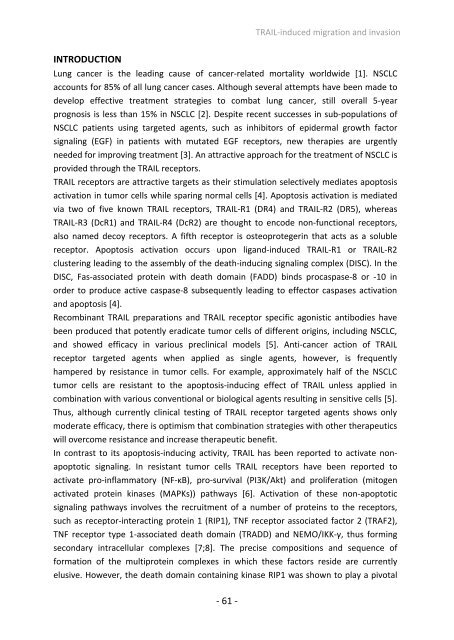towards improved death receptor targeted therapy for ... - TI Pharma
towards improved death receptor targeted therapy for ... - TI Pharma
towards improved death receptor targeted therapy for ... - TI Pharma
You also want an ePaper? Increase the reach of your titles
YUMPU automatically turns print PDFs into web optimized ePapers that Google loves.
INTRODUC<strong>TI</strong>ON<br />
TRAIL‐induced migration and invasion<br />
Lung cancer is the leading cause of cancer‐related mortality worldwide [1]. NSCLC<br />
accounts <strong>for</strong> 85% of all lung cancer cases. Although several attempts have been made to<br />
develop effective treatment strategies to combat lung cancer, still overall 5‐year<br />
prognosis is less than 15% in NSCLC [2]. Despite recent successes in sub‐populations of<br />
NSCLC patients using <strong>targeted</strong> agents, such as inhibitors of epidermal growth factor<br />
signaling (EGF) in patients with mutated EGF <strong>receptor</strong>s, new therapies are urgently<br />
needed <strong>for</strong> improving treatment [3]. An attractive approach <strong>for</strong> the treatment of NSCLC is<br />
provided through the TRAIL <strong>receptor</strong>s.<br />
TRAIL <strong>receptor</strong>s are attractive targets as their stimulation selectively mediates apoptosis<br />
activation in tumor cells while sparing normal cells [4]. Apoptosis activation is mediated<br />
via two of five known TRAIL <strong>receptor</strong>s, TRAIL‐R1 (DR4) and TRAIL‐R2 (DR5), whereas<br />
TRAIL‐R3 (DcR1) and TRAIL‐R4 (DcR2) are thought to encode non‐functional <strong>receptor</strong>s,<br />
also named decoy <strong>receptor</strong>s. A fifth <strong>receptor</strong> is osteoprotegerin that acts as a soluble<br />
<strong>receptor</strong>. Apoptosis activation occurs upon ligand‐induced TRAIL‐R1 or TRAIL‐R2<br />
clustering leading to the assembly of the <strong>death</strong>‐inducing signaling complex (DISC). In the<br />
DISC, Fas‐associated protein with <strong>death</strong> domain (FADD) binds procaspase‐8 or ‐10 in<br />
order to produce active caspase‐8 subsequently leading to effector caspases activation<br />
and apoptosis [4].<br />
Recombinant TRAIL preparations and TRAIL <strong>receptor</strong> specific agonistic antibodies have<br />
been produced that potently eradicate tumor cells of different origins, including NSCLC,<br />
and showed efficacy in various preclinical models [5]. Anti‐cancer action of TRAIL<br />
<strong>receptor</strong> <strong>targeted</strong> agents when applied as single agents, however, is frequently<br />
hampered by resistance in tumor cells. For example, approximately half of the NSCLC<br />
tumor cells are resistant to the apoptosis‐inducing effect of TRAIL unless applied in<br />
combination with various conventional or biological agents resulting in sensitive cells [5].<br />
Thus, although currently clinical testing of TRAIL <strong>receptor</strong> <strong>targeted</strong> agents shows only<br />
moderate efficacy, there is optimism that combination strategies with other therapeutics<br />
will overcome resistance and increase therapeutic benefit.<br />
In contrast to its apoptosis‐inducing activity, TRAIL has been reported to activate non‐<br />
apoptotic signaling. In resistant tumor cells TRAIL <strong>receptor</strong>s have been reported to<br />
activate pro‐inflammatory (NF‐ĸB), pro‐survival (PI3K/Akt) and proliferation (mitogen<br />
activated protein kinases (MAPKs)) pathways [6]. Activation of these non‐apoptotic<br />
signaling pathways involves the recruitment of a number of proteins to the <strong>receptor</strong>s,<br />
such as <strong>receptor</strong>‐interacting protein 1 (RIP1), TNF <strong>receptor</strong> associated factor 2 (TRAF2),<br />
TNF <strong>receptor</strong> type 1‐associated <strong>death</strong> domain (TRADD) and NEMO/IKK‐γ, thus <strong>for</strong>ming<br />
secondary intracellular complexes [7;8]. The precise compositions and sequence of<br />
<strong>for</strong>mation of the multiprotein complexes in which these factors reside are currently<br />
elusive. However, the <strong>death</strong> domain containing kinase RIP1 was shown to play a pivotal<br />
‐ 61 ‐













